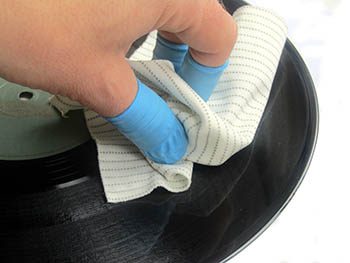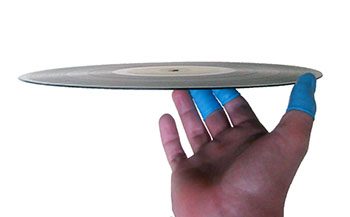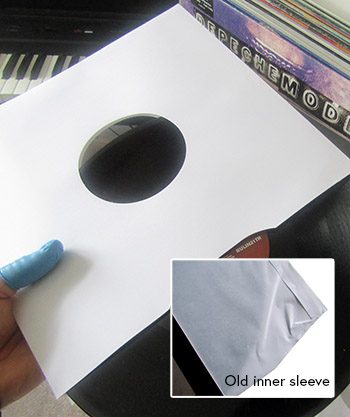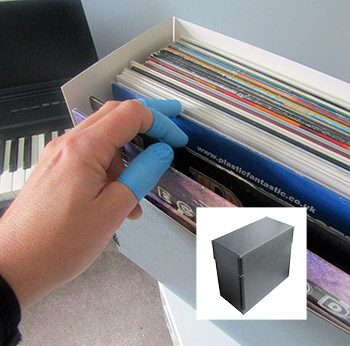Vinyl record collections are growing! the steady increase in sales and demand for the format continues to highs not seen for 25 years. Other than direct streaming of music, Vinyl is the only other format which has seen consistent growth year on year for the last 5 years.

Here's our 6 steps to record storage harmony - Is acid damaging your records? Why should you change inner sleeves? Should records be stored vertically or flat? Keep reading for the answers.
> | See all the items you need to protect and store your record collection here
What's the best way to store vinyl records?
Complete guide
1. Static

Like any object going into storage, it’s important to make sure that records are kept as clean as possible. Everyone, whether they have listened to a vinyl record or not, will be familiar with the sound of a scratch or static on a record, it’s the ‘go-to’ sound bed for any reproduction of an old recording. Vinyl records are like a magnet for dust, turntables will often encourage the static charge as they turn and the stylus drags on the record's surface. Dust collecting on the surface of the vinyl causes unwanted background static noise, and reduces the fidelity of the sound.
- While playing, make sure that the turntable cover is closed, this prevents additional dust being attracted to the record’s surface.
- Once playing is complete, before placing back into the inner sleeve, brush with an antistatic brush or wipe with an antistatic wipe to disperse the static charge. New technology for this job would include a high pressure electric duster, like the CompuCleaner Xpert which will effectively remove even stubborn dust without having to make contact with the record surface, and with no risk of static. Perform this away from the player and follow the grooves with the bristles, wipe or airflow.
> | For antistatic brushes click here > | For lint free antistatic wipes click here

2. Handling records
When holding a record it’s important not to allow oils from your hands to be pressed into the grooves. Trapped oils will in-turn trap dust and debris making it harder to clean and providing a breeding ground for mould, and cause noise when listening.
- When playing, handle records with (very) clean dry hands. Using finger cots (shown in the image) will provide extra grip and prevent any transfer of dirt and oil from your skin.
- Hold the record around the edge and centre, away from the grooves. This can be difficult when cleaning, so make sure you have some finger cots or clean nitrile gloves when you are cleaning a record.
>| For finger cots click here >

3. Cleaning a record
If a record has been played a number of times it could already have debris in the grooves, visible finger marks and other marks such as splashes from UFDs (unidentified flying drinks!) which you need to clean away before storing. The best way of checking by eye is by using an
LED torch (quite an unexpected result if you use UV light - google it!). There are a number of ways to clean a vinyl record, with grooves being susceptible to damage and trapped dust, thorough cleaning can be difficult and risky. The NEDCC have a great guide on how to wash a record, you can view it
here.
- Wet cleaning poses a risk to the record’s label and care should be taken to protect it
- Use de-ionised water for washing and rinsing
- A high quality lint-free (will not leave fibres behind) cloth such as the Dust Bunny or PEL microfibre cloth can be used to remove surface marks and water, Evolon is also a suitable absorbent material for drying clean records
- You should also clean the outer sleeve of any dust and fingerprints using the lint free cloth, again oily finger marks will damage the sleeve over time. If you have adhesive residue marks from old pricing labels on the sleeve, these can be removed using a crepe adhesive removal eraser.
>| For a museum specification lint-free cloth for cleaning vinyl records and sleeves click here >

4. Changing the inner sleeve
Although they offer protection from scratches when the record is removed/inserted into the outer sleeve, the original inner sleeve usually offers very little else in terms of protection and could be harming the record. Often made of low-grade paper, the original inner sleeve could be a source of dirt, dust and acid.
- Acids from the paper could accelerate the breakdown of the plasticisers in the record as well as causing damage to the outer sleeve
- Old inner sleeves can become creased which when under pressure could damage the surface of the record
- If the record was dirty the inner sleeve may still contain contaminants that could find their way back onto a clean record
- Acid free paper sleeves produce minimal static unlike plastic alternatives
- Sometimes the inner sleeve may contain information or have value, in which case it should be retained and stored separately.
>| Acid-free archival vinyl record inner sleeves here >.

5. Selecting a storage area for your record collection
The environment your records are stored in has a major influence on the longevity of the record and its sleeve. High humidity and fluctuations in temperature can lead to mould growth and accelerate deterioration, sunlight will fade sleeves, and extreme heat can warp vinyl, so there’s a bit to think about.
- Do not store near a radiator or window, there are a few reasons to avoid these areas. High temperatures over time can lead to distortion of the record. UV radiation, present in sunlight, will fade and speed up the deterioration of the card outer sleeve. Windows and radiators can be sources of water leaks which could easily ruin a collection.
- Keep away from cold external walls. Cold external walls are a haven for mould with; condensation, minimal light, minimal airflow, mould growth is inevitable, which in turn could encourage insect pests such as silverfish. Mould and mildew will stain your sleeves and grow in record grooves.
- Can you store records in a garage? Garages, sheds and lofts are not suitable spaces. These areas can fluctuate wildly in temperature and humidity which will cause stress to the record and sleeve as it swells and contracts. A stable cool(ish) temperature and humidity is important.
- Make sure they won’t get accidentally damaged or subject to vibrations, i.e. from a washing machine, or a 15" sub woofer!
You need to find a cool dry area away from potential sources of leaks. An inexpensive thermohygrometer will help you choose somewhere in your building that is suitable. The ideal RH (relative humidity) is around 35-40%. This can also be controlled using dessicants like Prosorb cassettes which absorb and desorb moisture to keep the RH stable.
>| Monitor your storage environment using a thermohygrometer, click here >

The final step is to archive your clean records in a box. If your collection is valuable it is best to box them in an acid free and archival quality
record box like this. This will help prevent accidental damage and protect from acids, dust, UV light and pests. Wood isn’t generally acceptable as a storage material, it will contain acids that will eventually migrate into the sleeves and in time affect the records.
- Store records of the same size together. Separate 12”, 10” and 7”, storing different sizes together causes uneven pressure on each record that isn't supported fully.
- Our archival record storage boxes are free from adhesives which could off-gas and cause damage to the contents.
- Should vinyl records be stored vertically or horizontally? Records shouldn’t be stored horizontally, or flat. As you will see, archival record boxes are designed for the records to be stood and stored vertically. Storing vinyl records flat can place too much pressure on the records lower in the stack causing damage over time.
- Never leave records leaning at angles when in a box or on a shelf, this will cause the vinyl to warp.
- If your collection is smaller, or you only need to box a few records, to offer full support and ensure they stay upright stuff the space with acid free tissue paper
- Indexing your collection with shelf marker cards can help minimise handling, our shelf marker cards are also acid free and safe for long term storage..
- Ensure there is enough space to easily remove a record from the box or shelf, this will prevent damage to the sleeve or record when removing or replacing.
- Avoid wood containers and crates, or plastics that may contain PVC, they are sources of acid and will cause damage in long term storage
>| For archival acid free vinyl record storage boxes in 7", 10" and 12" sizes click here >
>| View the full range of archival media storage here >
For antistatic cloths click here, and antistatic brushes click here
For Lint-free cleaning cloths for records here
For Replacement record inner sleeves, click here
For Archival acid free vinyl record storage boxes click here
There are other sizes of phonographic records available, including 16" transcription discs and smaller miniature special formats. We can make archival boxes for any size record, just contact us here, or go to our bespoke box making site boxsite.co.uk.